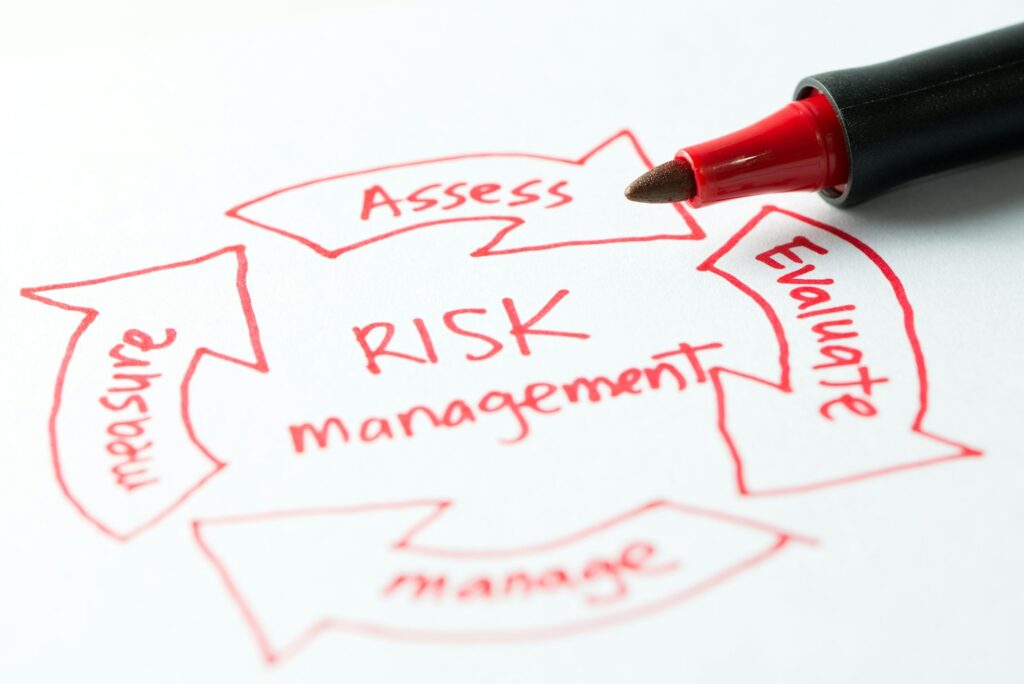
Welcome to the world of IT project management! If you’re looking to boost your team’s performance and streamline your project goals, implementing Objectives and Key Results (OKRs) might be the game-changer you need.
But what exactly are OKRs, and how can they transform your approach to managing IT projects? In this article, we’ll dive into the nuts and bolts of OKRs, illustrating their relevance and benefits in the realm of IT project management.
OKRs have been adopted by leading companies worldwide for a reason:
As John Doerr, a pioneer of OKRs, once said, “Ideas are easy.
Execution is everything.” This underscores the importance of a structured approach to achieve extraordinary results. Join us as we explore how OKRs can transform your IT project management and lead your team to success.

To successfully implement OKRs for IT project success, start by clearly defining your objectives. Ensure they are specific, measurable, attainable, relevant, and time-bound (SMART).
These objectives should align with your organization’s overall vision and strategic goals. For example, an objective might be to enhance cybersecurity measures across all deployed platforms by the year’s end.
Once the objectives are set, identify the key results that will measure the progress toward achieving each objective. Key results should be quantifiable and provide a clear path to success.
For instance, a key result for the cybersecurity objective could be to reduce unauthorized access incidents by 40% within six months.
Next, communicate these OKRs effectively to your team and organization. Transparency is crucial, as it ensures that everyone understands the goals and the part they play in reaching them.
Encourage participation from all levels of the team when drafting OKRs to guarantee alignment with roles and responsibilities. This collaborative approach fosters ownership and commitment.
Regularly review and adjust OKRs as needed. The dynamic nature of IT projects means that priorities can shift, and unforeseen challenges can arise.
Scheduling frequent check-ins and updates ensures that your team remains aligned and can adapt quickly to any changes. These sessions also provide an opportunity to celebrate achievements and identify areas for improvement.
Finally, leverage technology tools to track and manage OKRs efficiently.
Tools such as OKR software platforms can streamline the process, provide real-time visibility into progress, and integrate seamlessly with other project management tools you may already be using.
This integration promotes a cohesive management approach, ensuring that OKRs remain central to your IT project management strategy.
First and foremost, communicate your OKRs clearly to both your team and the broader organization. Transparency is key.
When everyone understands the goals and how they align with the company’s vision, it fosters a sense of shared purpose and direction.
Next, involve your team in the process of writing OKRs. This collaborative approach ensures that the OKRs are realistic and that everyone feels a sense of ownership and responsibility toward achieving them.
Additionally, it helps in aligning OKRs with individual roles and responsibilities, making them more actionable.
Another crucial practice is to review and adjust OKRs regularly. IT projects are often dynamic, with rapidly changing requirements and objectives.
By consistently revisiting your OKRs, you can ensure they remain relevant and continue to drive your project towards success.
Also, leverage OKRs to improve specific processes within your IT team. Set clear, measurable objectives that target areas like cybersecurity awareness, disaster recovery improvements, and development speed.
For instance, an OKR could be aimed at reducing the average incident response time by 20% within a quarter.
Don’t forget to cascade OKRs from the organizational level down to individual teams. This ensures alignment at all levels and makes it easier to track progress and identify bottlenecks.
Each team’s objectives should clearly support the overarching goals of the organization.
Lastly, integrate your OKRs into your agile methodology. Agile and OKRs share a focus on continuous improvement and flexibility.
By synchronizing these frameworks, you can enhance your team’s productivity and adaptability, ensuring that everyone is moving in the same direction while retaining the ability to pivot when necessary.

To craft clear and achievable OKRs, you must start with well-defined objectives that are both inspiring and practical. Your objectives need to be ambitious enough to push boundaries while remaining grounded in reality.
They should provide your team with a clear vision and direction.
Begin by asking yourself what you want to achieve in the next quarter. What are the critical areas that need improvement or development? Answering these questions will help you create objectives that align with your organization’s overall goals.
Remember that an objective should be a single sentence that encapsulates your aim in a compelling and actionable way.
Next, break down each objective into key results. These are the specific, quantifiable outcomes that will measure your progress toward the objective. Effective key results should be:
For instance, if your objective is to enhance system performance, your key results might include:
Involve your team in writing OKRs to ensure they are aligned with their roles and responsibilities. Collaboration fosters a sense of ownership and accountability, driving greater commitment to achieving the set goals.
Lastly, communicate your OKRs effectively across the team and organization.
Visibility is key; make sure everyone understands their individual contributions to the bigger picture, and revisit these OKRs regularly to track progress and make necessary adjustments.

Effective risk management is crucial in IT projects, and OKRs can play a pivotal role in this area. By clearly defining objectives and key results, you establish a structured approach to identify, assess, and mitigate risks.
Below, we delve into some actionable strategies to harness OKRs for superior risk management in IT projects:
Identify Potential Risks: Start by integrating risk identification into your OKR planning process. For instance, objectives could be crafted to enhance security protocols or improve incident response times.
Key results might include specific metrics like reducing the number of security breaches by a certain percentage.
Assess and Prioritize Risks: Not all risks are created equal. Use OKRs to assess the potential impact of different risks.
Objectives can highlight high-priority risks, such as system downtime or data loss, with key results focusing on response plans and backup strategies.
Develop Mitigation Strategies: Once risks are identified and prioritized, the next step involves developing mitigation strategies. This is where OKRs shine.
For example, an objective could be to enhance disaster recovery processes, with key results that include testing recovery protocols quarterly and ensuring critical systems are back online within a specified timeframe.
Monitor and Review: Risk management is an ongoing process. Adjust your OKRs dynamically to ensure continuous improvement. Regularly review your key results to track progress and make necessary adjustments.
If a certain risk metric isn’t improving, reevaluate your strategies and shift the focus as needed.
Foster a Risk-Aware Culture: Perhaps one of the most significant benefits of using OKRs for risk management is cultivating a risk-aware culture.
By involving your team in the OKR-setting process, you ensure that everyone is aware of potential risks and their role in mitigating them. This collective effort helps in building resilient and responsive project environments.
By embedding risk management into your OKRs, you take a proactive stance on potential issues, leading to more resilient and successful IT projects.
This guided approach not only minimizes risks but also aligns your team with the overarching goals of the organization, ensuring everyone works towards a common objective with clarity and purpose.
Integrating OKRs (Objectives and Key Results) with Agile methodologies can bring substantial benefits to your IT projects by fostering transparency, aligning efforts, and maintaining a sharp focus on outcomes.
The key lies in understanding and leveraging the strengths of both approaches to complement each other effectively.
Agile methodologies, such as Scrum and Kanban, emphasize iterative progress, continuous feedback, and flexibility.
When paired with OKRs, which focus on setting and tracking specific, measurable goals, your team can achieve a powerful synergy. Here’s how you can make this integration work seamlessly:
By aligning OKRs with Agile practices, you not only maintain a strong focus on high-level goals but also adapt swiftly to changes and feedback.
This integrated approach helps in managing risks more effectively, ensuring that your IT projects remain resilient, adaptable, and aligned with strategic objectives.
Remember, the essence of both Agile methodologies and OKRs is to drive continuous improvement and deliver value incrementally.
When combined, they create a robust framework that empowers your IT team to achieve significant and sustainable results.

OKRs can work wonders in transforming IT project outcomes. They do so by setting clear and compelling goals that everyone in the team can rally around.
When you define Objectives and Key Results that focus on key priorities, team members are better able to understand how their individual efforts contribute to the bigger picture.
This clarity not only fosters a sense of purpose but also drives motivation and engagement.
Consider the example of an IT project aimed at enhancing cybersecurity. An objective could be, “Significantly improve the organization’s cybersecurity posture.” The key results might then include:
Each of these key results is specific, measurable, and time-bound, which makes tracking progress straightforward.
By aligning these OKRs with the overall strategic goals of the organization, you create a roadmap that everyone can follow, ensuring that efforts are coherent and directed where they are most needed.
An essential aspect of transforming IT project outcomes with OKRs is the iterative review process. Regular check-ins and reviews allow teams to adjust their strategies in real-time, which is particularly valuable in the fast-paced world of IT.
These reviews help in identifying what is working, what isn’t, and what adjustments are needed to stay on track.
Moreover, the transparency that OKRs bring can significantly enhance collaboration and communication within and between teams.
When OKRs are shared openly, it is easier for different departments to understand each other’s priorities and constraints, which can lead to more effective collaboration and resource allocation.
In sum, by effectively implementing OKRs, you are not just setting goals but are embedding a culture of accountability, continuous improvement, and strategic alignment, all of which are critical for transforming IT project outcomes from good to great.
Fostering employee engagement and motivation can be a challenge, but implementing OKRs provides a structured yet flexible approach to achieve it.
By involving team members in the OKR creation process, you empower them to take ownership of their goals and responsibilities.
This not only aligns individual and team objectives with organizational priorities but also boosts morale and a sense of purpose.
When team members feel that their contributions are directly tied to the company’s success, it creates a more engaged and motivated workforce.
OKRs are particularly effective because they can be ambitious, encouraging employees to stretch their capabilities and think creatively about how to achieve their objectives.
This kind of goal-setting promotes a culture of innovation and progress.
Regular check-ins and updates also play a critical role in keeping the team engaged. By frequently reviewing progress and acknowledging achievements, you provide continuous feedback that helps maintain momentum and motivation.
Additionally, these check-ins offer an opportunity to address any hurdles and readjust OKRs as necessary, keeping the goals relevant and attainable.
Furthermore, cascading OKRs from the organizational level to individual teams ensures that everyone understands how their work contributes to the broader mission, fostering a cohesive and unified effort.
This approach improves alignment and makes employees feel valued, further enhancing their engagement.
Ultimately, OKRs not only set a clear direction but also nurture a result-oriented culture where the focus is on meaningful and valuable outcomes.
This culture not only drives performance but also creates a workplace where employees are motivated to bring their best selves to work every day.
1. Misalignment with Business Objectives: One of the biggest challenges is ensuring that OKRs are aligned with the broader business objectives. Without this alignment, there can be a disconnect, leading to wasted resources and effort.
2. Over-ambitious Goals: Setting overly ambitious OKRs can demotivate the team if the goals are perceived as unattainable. It’s important to strike a balance between challenging and achievable objectives.
3. Lack of Clarity: Unclear or poorly defined OKRs can lead to confusion and misdirection. Objectives and Key Results need to be specific, measurable, achievable, relevant, and time-bound (SMART).
4. Insufficient Tracking: Once OKRs are set, consistent tracking and evaluation are necessary. Without proper tracking, it’s difficult to measure progress and make necessary adjustments.
1. Understanding the Business Vision: Begin by understanding the overarching business vision and mission. This will provide a clear context within which IT project goals should be framed.
2. Collaborative Planning: Involve key stakeholders from both the IT department and other business areas during the planning phase. This ensures that everyone is on the same page and that the OKRs support broader objectives.
3. Break Down Goals: Once the high-level goals are set, break them down into smaller, actionable OKRs. Each OKR should contribute directly to the overall project objectives and, ultimately, the business goals.
1. Regular Check-ins: Schedule regular check-ins, such as weekly or bi-weekly meetings, to review progress. This helps to keep everyone accountable and allows for quick adjustments if needed.
2. Transparent Tracking Tools: Use project management and tracking tools that provide transparency. Tools like Jira, Trello, or Asana can help teams monitor progress and address challenges in real-time.
3. Continuous Feedback: Encourage continuous feedback within the team. Open communication can help identify roadblocks early and provide opportunities for collaborative problem-solving.
1. Facilitators: Managers act as facilitators in the OKR process. They help define and communicate the OKRs, ensuring they are aligned with business objectives.
2. Supporters: Managers provide the necessary support and resources to help their team achieve the set OKRs. This may include additional training, tools, or clarifying expectations.
3. Motivators: Keeping the team motivated and focused is another key role. Managers should recognize and celebrate milestones and accomplishments to maintain morale and engagement.
4. Evaluators: Managers are responsible for regularly reviewing progress against the OKRs, providing constructive feedback, and making adjustments as necessary.
1. Quantitative Metrics: Use quantitative metrics to measure the success of OKRs. This could include the number of completed tasks, milestones achieved, or improvements in key performance indicators (KPIs).
2. Outcome vs. Output: Focus on the outcomes rather than just the outputs. For instance, instead of just measuring the number of features delivered, evaluate the impact those features have on user satisfaction or business performance.
3. Regular Reviews: Conduct regular reviews at the end of each OKR cycle. Assess what worked, what didn’t, and why. Use these insights to refine the process for the next cycle.
4. Feedback Loop: Establish a feedback loop with stakeholders. Collect feedback on what value the OKRs have added and how they have helped in achieving project and business goals.
Implementing OKRs in IT project management is truly transformative. Not only do they provide a clear roadmap for achieving project goals, but they also foster a culture of transparency, accountability, and continuous improvement.
By aligning your team’s efforts with well-defined objectives and measurable key results, you can drive performance, enhance collaboration, and ultimately, deliver successful IT projects consistently.
Start by setting actionable and realistic OKRs that are aligned with your overarching organizational goals. Regularly review and adjust them to stay on track and adapt to any changes. Remember, the key to success lies in the consistent and disciplined execution of these OKRs.
Adopting OKRs might seem challenging at first, but with commitment and practice, it can significantly improve your project outcomes.
Ready to revolutionize your IT project management? Begin your journey with OKRs today and watch as your projects reach new heights of success and efficiency.
Thank you for exploring the power of OKRs in IT project management with us. Here’s to your success!



